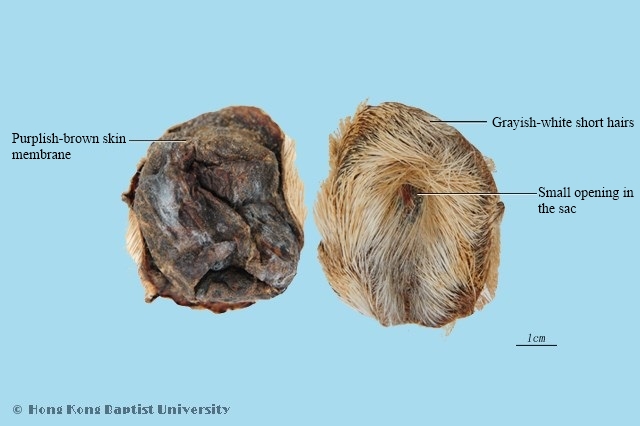|
|
|
麝香 Shexiang

|
Chinese Name |
麝香 |
|
|
Chinese Pinyin |
Shexiang |
|
English Name |
Forest Musk
Abelmosk |
|
Latin Pharmaceutical Name |
Moschus |
|
Category |
Zoological substances |
|
Origin |
The dried secretions from the mature musk sac from the male musk deer Moschus berezovskii Flerov, Moschus sifanicus Przewalski, Moschus moschiferus Linnaeus. (Cervidae). Wild musk deer is generally hunted from winter until the following spring. After being captured, the musk sac is cut out and dried in the dark, and is called mao qiao she xiang (hairy-shell she xiang); after the musk sac is cut open and the shell of the sac is removed, it is called she xiang ren (musk kernel). In domesticated animals, the musk kernel is derectly removed from the musk sac and either dried in the dark or dried in a sealed drying device. |
|
Production Regions |
Primarily produced in the Chinese provinces of Tibet, Sichuan, Yunnan. |
|
Macroscopic Features |
Mao qiao she xiang: Flat spherical or sub-oval shaped sac, 3~7cm diameter, 2~4cm thick. Opening side is leathery, brown, slightly flat, densely covered with white or grayish-brown short hairs, arranged from two sides toward the center, with one small sac hole in the center. Another side has brown and slightly purple membranous skin, slightly wrinkled, occasionally has muscular fibers, slightly flexible, after being cut open, the middle membranous skin is brown or grayish-brown, translucent, inner membranous skin is brown, inside has granular, powdery "she xiang ren" ("musk kernels") and few thin hairs and fallen inner membranous skin.
She xiang ren: Wild specimens are soft, oily, loose; the granular kernels are called ‘dang men zi’, irregular spherical or granular shape, purplish-black, with oily luster, slightly pitting pattern, fractured surface is dark brown or yellowish-brown, powder is often brown or yellowish-brown, occasionally has fallen inner membranous skin and thin hairs. Domesticated specimens are granular, short strip-like or irregular lumps; externally uneven, purplish-black or dark brown, oily, slightly lustrous, occasionally has some hairs and fallen inner membranous skin. Potent distinctively aromatic odor, slightly spicy, slightly bitter and salty taste. |
|
Quality Requirements |
Superior medicinal material is full, with thin skin, flexible, with potent aroma. |
|
Properties |
Acrid, warm |
|
Functions |
Opens orifices, arouses spirit, invigorates blood, frees channels, eliminates swelling, relieves pain. apply to coma induced by heat diseases, stroke with phlegm syncope, stagnation of qi sudden syncope, coma affected by evil, amenorrhea, abdominal mass, dystocia and stillbirth, sudden pain of heart and abdominal, swelling abscess and scrofula, swelling and pain of throat, pain and injury from falls, impediment. |
|
Remark |
1. Forest Musk Deer (Moschus berezovskii) is listed as "Endangered" in the International Union for the Conservation of Nature and Natural Resources (IUCN) Red List of Threatened Species. Also, it is listed in the Convention on International Trade in Endangered Species of Wild Fauna and Flora (CITES) Appendix II. Its trade is allowed but subject to licensing controls. (Except the populations of Afghanistan, Bhutan, India, Myanmar, Nepal and Pakistan, which are included in Appendix I)
2. Alpine Musk Deer (Moschus sifanicus) is listed as "Endangered" in the International Union for the Conservation of Nature and Natural Resources (IUCN) Red List of Threatened Species. Also, it is listed in the Convention on International Trade in Endangered Species of Wild Fauna and Flora (CITES) Appendix II. Its trade is allowed but subject to licensing controls. (Except the populations of Afghanistan, Bhutan, India, Myanmar, Nepal and Pakistan, which are included in Appendix I)
3. Siberian Musk Deer (Moschus moschiferus) is listed as "Vulnerable " in the International Union for the Conservation of Nature and Natural Resources (IUCN) Red List of Threatened Species. Also, it is listed in the Convention on International Trade in Endangered Species of Wild Fauna and Flora (CITES) Appendix II. Its trade is allowed but subject to licensing controls. (Except the populations of Afghanistan, Bhutan, India, Myanmar, Nepal and Pakistan, which are included in Appendix I) |
| Link |
 Medicinal Plant Images Database Medicinal Plant Images Database
 Chinese Medicinal Formula Images Database Chinese Medicinal Formula Images Database
 Chinese Medicine Specimen Database Chinese Medicine Specimen Database
|
|
Permanent URL:https://sys01.lib.hkbu.edu.hk/cmed/mmid/detail.php?pid=B00389 |
|
|
|

